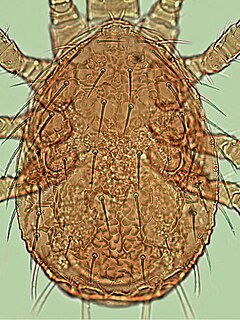Related Research Articles
Hypoaspis is a genus of mites in the family Laelapidae.

Amblyseius is a large genus of predatory mites belonging to the family Phytoseiidae. Many members of this genus feed on other mites such as red spider mites, and also on thrips. Several species are popular as biological control agents to control these pests.
Proprioseiopsis is a genus of mites in the family Phytoseiidae.
Dendrolaelaps is a genus of mites in the family Digamasellidae.

Pachylaelapidae is a family of mites in the order Mesostigmata.
Eviphididae is a family of mites in the order Mesostigmata.
Ameroseiidae is a family of mites in the order Mesostigmata.

Ameroseius is a genus of mites in the family Ameroseiidae. There are more than 60 described species in Ameroseius.

Proctolaelaps is a genus of mites in the family Ascidae.

Halolaelapidae is a family of mites in the order Mesostigmata.
Uroseius is a genus of mites in the family Trachytidae.
Nenteriidae is a family of mites in the order Mesostigmata.
Austrodinychus is a genus of mites in the family Nenteriidae.
Longitrichanenteria is a genus of mites in the family Nenteriidae.
Ruehmnenteria is a genus of mites in the family Nenteriidae.
Trichouropoda is a genus of mites in the family Trematuridae.

Uroobovella is a large genus of mites in the family Urodinychidae.
Dinychidae is a family of mites in the order Mesostigmata.

Uropodidae is a family of mites in the order Mesostigmata.

Oplitidae is a family of mites in the order Mesostigmata.
References
- ↑ Joel Hallan (ed.). "Nenteriidae Species Listing". Biology Catalog. Texas A&M University . Retrieved September 6, 2010.